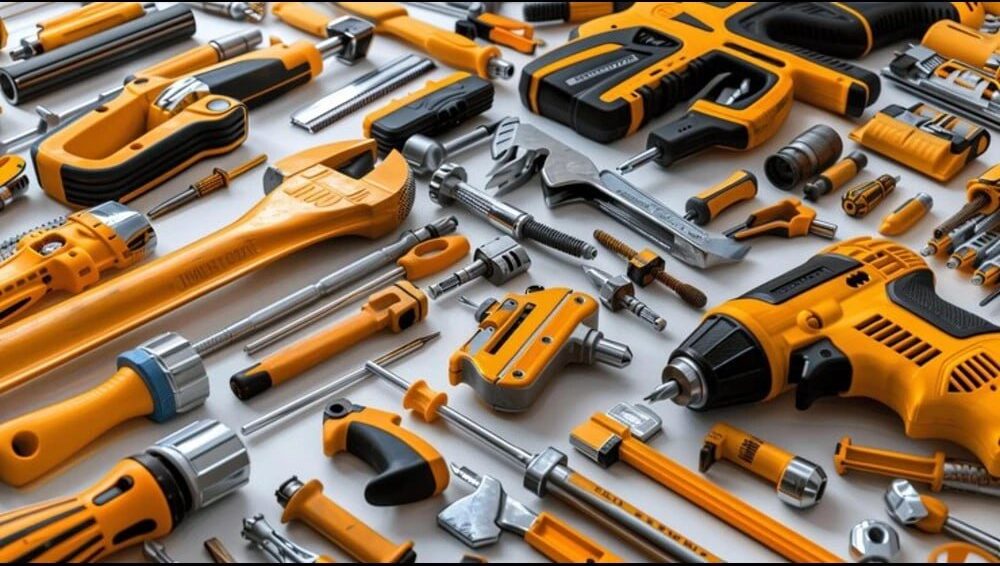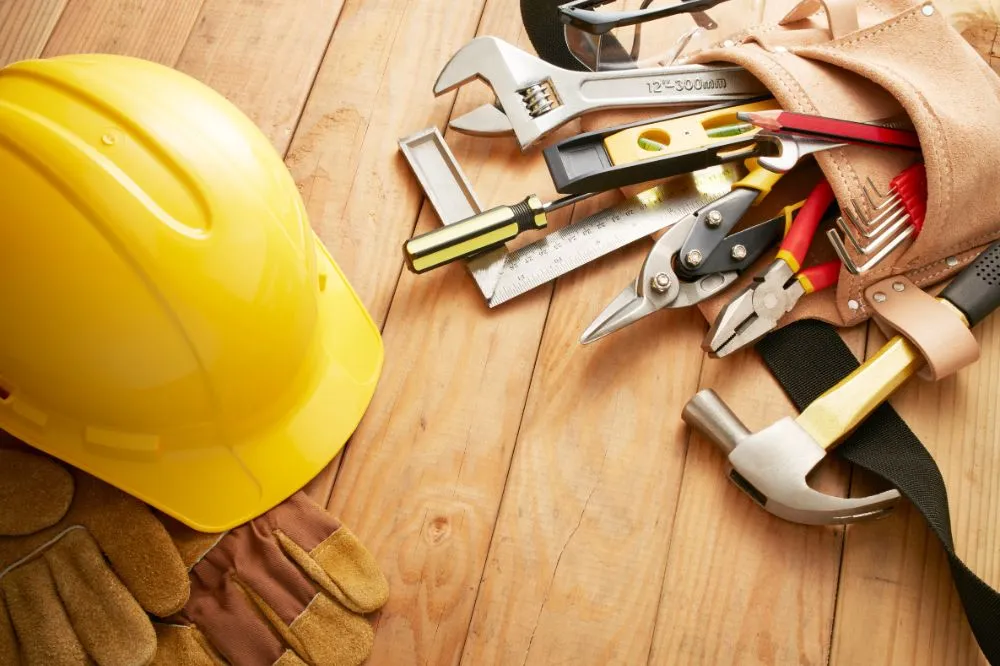Last Updated on August 28, 2024 by hamid_firuzi
In the world of construction, having the right tools is not just about getting the job done—it’s about getting it done efficiently, safely, and to the highest standard. Whether you’re managing a large-scale commercial build or a small residential renovation, the tools you use can significantly impact the outcome of your project. This complete checklist of essential tools for construction projects will help you equip your site for success, ensuring that every phase of construction is covered.
1. Hand Tools: The Foundation of Construction
Hand tools are the backbone of any construction project. These tools are indispensable for a variety of tasks, from measuring and marking to cutting and fastening. Some of the most crucial hand tools include:
- Hammer: A basic tool used for driving nails, fitting parts, and breaking objects. It’s a must-have in every construction toolkit.
- Tape Measure: Precision is key in construction. A high-quality tape measure ensures accurate measurements, which is critical for the overall success of the project.
- Chisels and Screwdrivers: These tools are essential for fine work such as carving, cutting, and driving screws.
- Utility Knife: Versatile and useful for cutting a variety of materials, a sharp utility knife is essential for precise work.
- Level: Ensuring that structures are level is fundamental in construction. A reliable level helps prevent errors and ensures structural integrity.
Investing in durable hand tools can save time and reduce the likelihood of errors, making them an essential part of your construction arsenal.
2. Power Tools: Speed and Precision
While hand tools are essential, power tools bring speed and precision to the table, enabling workers to handle more complex and labor-intensive tasks efficiently. Some of the most important power tools include:
- Power Drill: Used for drilling holes and driving screws, a power drill is a versatile tool that every construction site needs.
- Circular Saw: Perfect for cutting through wood, metal, and other materials, a circular saw is vital for any cutting tasks.
- Jigsaw: For more intricate cuts and curves, a jigsaw provides the flexibility needed for detailed work.
- Angle Grinder: This tool is essential for cutting, grinding, and polishing, particularly on metal and stone surfaces.
- Nail Gun: Speed up the process of nailing with a nail gun, which is especially useful for framing and other tasks that require numerous nails.
Power tools not only increase productivity but also improve the accuracy of your work, making them indispensable on any construction site.
3. Safety Equipment: Protecting Your Workforce
Safety is paramount in construction. Ensuring that your team is equipped with the right safety equipment can prevent accidents and protect against potential hazards. Essential safety gear includes:
- Hard Hats: Protecting the head from falling debris and other hazards, hard hats are a non-negotiable item on any construction site.
- Safety Glasses and Face Shields: Eye protection is crucial when working with power tools and chemicals. Safety glasses and face shields protect against flying debris and splashes.
- Gloves: Heavy-duty work gloves protect hands from cuts, abrasions, and chemical exposure.
- Ear Protection: Construction sites are loud environments. Ear protection such as earplugs or earmuffs helps prevent hearing damage.
- High-Visibility Clothing: Ensuring workers are easily seen by others on the site, high-visibility vests and jackets are crucial for preventing accidents.
- Safety Harnesses and Lanyards: For working at heights, safety harnesses and lanyards are essential to prevent falls.
Investing in high-quality safety equipment not only ensures compliance with regulations but also safeguards the well-being of your workforce.
4. Heavy Machinery: Handling Large-Scale Tasks
For larger construction projects, heavy machinery is essential. These machines handle tasks that are too large or strenuous for manual labor, such as excavation, demolition, and lifting. Key pieces of heavy machinery include:
- Excavators: Used for digging and moving large amounts of earth, excavators are essential for site preparation and foundation work.
- Bulldozers: These powerful machines are used for pushing large quantities of soil, sand, and debris, making them indispensable for clearing sites.
- Cranes: For lifting heavy materials to high places, cranes are crucial in both building and demolition projects.
- Forklifts: Used for lifting and transporting heavy materials over short distances, forklifts are vital for material handling on site.
- Concrete Mixers: For mixing and pouring concrete, a concrete mixer is necessary for any project involving foundations, slabs, or other concrete structures.
Ensuring that your site has the appropriate heavy machinery can dramatically increase the efficiency and scope of your construction project.

5. Measuring and Layout Tools: Ensuring Precision
Accurate measurements and proper layout are critical to the success of any construction project. Measuring and layout tools ensure that everything is built according to plan. Essential tools include:
- Laser Levels: For precise leveling and alignment, laser levels are far superior to traditional levels, offering accuracy and ease of use.
- Theodolites: These tools are used for measuring horizontal and vertical angles, essential for laying out a site and ensuring structures are built to the correct specifications.
- Plumb Bobs: A simple yet effective tool, the plumb bob ensures that structures are perfectly vertical.
- Surveying Equipment: This includes total stations, GPS devices, and other tools used to accurately measure and map out the site.
- Marking Tools: Chalk lines, markers, and pencils are used to mark measurements and guides on materials.
Using advanced measuring and layout tools not only ensures the accuracy of your construction project but also reduces the likelihood of costly mistakes.
6. Material Handling Tools: Efficiency and Organization
Managing materials efficiently is a critical aspect of any construction project. Material handling tools help move, store, and organize materials on site, ensuring that everything is readily available when needed. Important tools in this category include:
- Wheelbarrows and Hand Trucks: These are essential for moving heavy materials and tools around the site.
- Pallet Jacks: For moving pallets of materials, pallet jacks are indispensable in any warehouse or construction setting.
- Hoists and Lifts: These tools are used for lifting heavy materials to higher levels, reducing the physical strain on workers.
- Scaffolding: Essential for reaching high places, scaffolding provides a safe and stable platform for workers.
- Material Storage Solutions: Proper storage solutions, such as racks, bins, and containers, keep materials organized and easily accessible.
Effective material handling not only streamlines the construction process but also improves site safety and organization.
Conclusion
Equipping your construction site with the right tools is the foundation of any successful project. From hand tools to heavy machinery, each tool plays a critical role in ensuring that your project is completed efficiently, safely, and to the highest standard. By following this complete checklist, you can ensure that your site is well-prepared to handle any challenge that arises.
At Taleb Kasimy, we understand the importance of having the right tools and equipment on site. Whether you’re a seasoned contractor or a newcomer to the construction industry, this checklist will serve as a valuable resource to help you navigate your next project. Remember, the key to a successful construction project lies in preparation and the proper selection of tools.

